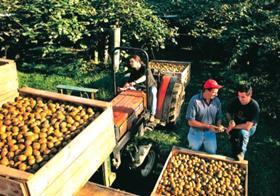
New Zealand-based fresh produce distributor and exporter Turners and Growers (T&G) has backed a recently announced government move to ensure innovation in the kiwifruit industry through the development of new varieties.
However, the group has said that the seven-year time frame for research and development funding could be too long, with the country's growerspotentially missing out on being the Southern Hemisphere's leading grower of 'lucrative new varieties that are available now'.
An announcement by the country's Minister of Research, Science and Technology Dr Wayne Mapp yesterday (9 November) revealed that funding will be increased to NZ$35.7m (US$26.3m, €165.6m) over the next seven years.
The investment will more than double the funding available to the current research cooperation between kiwifruit marketer Zespri and crown body Plant & Food Research.
T&G said that the greatest opportunity for growers is in new varieties, with 80 per cent of the country's crop made up of green kiwifruit, and said that it had been actively investigating and developing new varieties for several years, gaining initernational recognition at the recent ASIA FRUIT LOGISTICA tade event in Hong Kong.
Group chairman Tony Gibbs said that commercial demand for these new varieties was proven in Hong Kong, and that it was good to see the government 'pushing Zespri' to develop new varieties.
T&G has actively called this year for an end to Zespri's 'monopolistic' status as part of the country's single-desk export system for kiwifruit.
'While government assistance for new varieties will be welcomed, if the market was a free one the innovation would naturally happen,' Mr Gibbs said. 'It would happen much faster and the taxpayer wouldn't be picking up the tab.
'Turners & Growers Red is already being grown and sold commercially with well advanced plans for a major commercial planting,' he continued. 'Over the next 12 months, Turners & Growers will need to decide the predominant growing region for ENZA Red. Our preference, of cours, is to continue to invest and innovate in New Zealand. However, the current monopoly structure means that Turners & Growers must investigate other Southern Hemisphere growing regions where there are no export restrictions and freedom of trade.
The future of the kiwifruit industry lies in growing the category internationally. International supermarkets want exciting, new varieties that will expand the shelf space that our fruit can demand in the big supermarkets,' Mr Gibbs concluded. 'To strengthen the future of the New Zealand kiwifruit industry and secure maximum returns, New Zealand growers need choice in the type of fruit they grow and in who exports them.'



